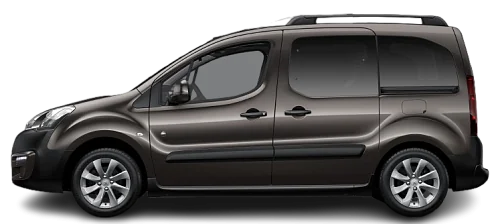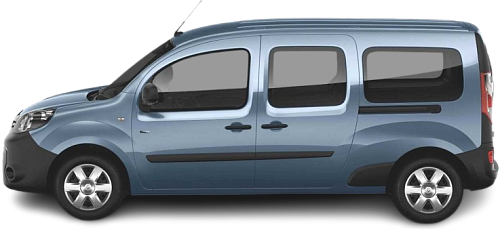Global EV Comparison: Peugeot Partner Tepee Electric vs Renault Kangoo Z.E. (E-Tech) 33 Maxi
Struggling to Decide? Let AI Help!
Your AI Summary Is Ready!
General Info
Since both vehicles have been discontinued, they are now only available on the used car market. You can get the Peugeot Partner Tepee Electric (2017-2020) for as low as €12990, while the Renault Kangoo Z.E. 33 Maxi (2017-2022) begins at €8890.
The two vehicles share the same body style: Minivan.
| Property | Peugeot Partner Tepee Electric | Renault Kangoo Z.E. (E-Tech) 33 Maxi |
|---|---|---|
| Years of Production | 2017-2020 | 2017-2022 |
| Current Status | Discontinued | Discontinued |
| Country of Manufacture | UK | France |
| Body Style | Minivan | Minivan |
| Market Availability | EU | EU |
| Price Europe (Used) | €12990 | €8890 |
| GCC Score | 4.5 | 5.1 |
Range and Efficiency
The Renault Kangoo Z.E. 33 Maxi (2017-2022) boasts a greater real-world range, a larger battery, and superior energy efficiency compared to the Peugeot Partner Tepee Electric (2017-2020).
| Property | Peugeot Partner Tepee Electric | Renault Kangoo Z.E. (E-Tech) 33 Maxi |
|---|---|---|
| Range (WLTP) | 106 km | 230 km |
| Range (GCC) | 109 km | 199 km |
| Battery Capacity (Nominal) | 22.5 kWh | 33 kWh |
| Battery Capacity (Usable) | 20.5 kWh | 31 kWh |
| Efficiency per 100 km | 18.8 kWh/100 km | 15.6 kWh/100 km |
| Efficiency per kWh | 5.32 km/kWh | 6.42 km/kWh |
| Range and Efficiency Score | 4.1 | 5.6 |
Charging
Both vehicles utilize a standard 400-volt architecture.
The Renault Kangoo Z.E. 33 Maxi (2017-2022) has no DC fast charging capability, whereas the Peugeot Partner Tepee Electric (2017-2020) can charge at up to 40 kW.
The Renault Kangoo Z.E. 33 Maxi (2017-2022) features a more powerful on-board charger, supporting a maximum AC charging power of 7 kW, whereas the Peugeot Partner Tepee Electric (2017-2020) is limited to 3.7 kW.
| Property | Peugeot Partner Tepee Electric | Renault Kangoo Z.E. (E-Tech) 33 Maxi |
|---|---|---|
| Max Charging Power (AC) | 3.7 kW | 7 kW |
| Max Charging Power (DC) | 40 kW | - Max Charging Power (DC) |
| Architecture | 400 V | 400 V |
| Charge Port | CHAdeMO | Type 2 (Mennekes) |
| Charging Score | 3.1 | 3.1 |
Performance
Both vehicles are front-wheel drive.
The Peugeot Partner Tepee Electric (2017-2020) boasts greater motor power and accelerates faster from 0 to 100 km/h.
| Property | Peugeot Partner Tepee Electric | Renault Kangoo Z.E. (E-Tech) 33 Maxi |
|---|---|---|
| Drive Type | FWD | FWD |
| Motor Type | PMSM | PMSM |
| Motor Power (kW) | 49 kW | 44 kW |
| Motor Power (hp) | 66 hp | 59 hp |
| Motor Torque | 200 Nm | 225 Nm |
| 0-100 km/h | 19.5 s | 22.4 s |
| Top Speed | 110 km/h | 130 km/h |
| Performance Score | 1.2 | 1.4 |
Dimensions
The Renault Kangoo Z.E. 33 Maxi (2017-2022) is longer, but has a similar width and height to the Peugeot Partner Tepee Electric (2017-2020).
The Renault Kangoo Z.E. 33 Maxi (2017-2022) boasts a more extended wheelbase.
| Property | Peugeot Partner Tepee Electric | Renault Kangoo Z.E. (E-Tech) 33 Maxi |
|---|---|---|
| Length | 4380 mm | 4666 mm |
| Width (with Mirrors) | - Width (with Mirrors) | 2138 mm |
| Width (w/o Mirrors) | 1857 mm | 1829 mm |
| Height | 1822 mm | 1802 mm |
| Wheelbase | 2728 mm | 3081 mm |
Cargo and Towing
The Renault Kangoo Z.E. 33 Maxi (2017-2022) provides more cargo capacity, featuring both a larger trunk and more space with the rear seats folded.
Neither car is equipped with a frunk (front trunk).
The Renault Kangoo Z.E. 33 Maxi (2017-2022) has a towing capacity of up to 322 kg, whereas the Peugeot Partner Tepee Electric (2017-2020) is not officially rated for towing in the EU.
| Property | Peugeot Partner Tepee Electric | Renault Kangoo Z.E. (E-Tech) 33 Maxi |
|---|---|---|
| Number of Seats | 5 | 5 |
| Curb Weight | 1679 kg | 1585 kg |
| Cargo Volume (Trunk) | 544 l | 1300 l |
| Cargo Volume (Max) | 2400 l | 3400 l |
| Cargo Volume (Frunk) | - Cargo Volume (Frunk) | - Cargo Volume (Frunk) |
| Towing Capacity | - Towing Capacity | 322 kg |
| Cargo and Towing Score | 7.1 | 8 |




